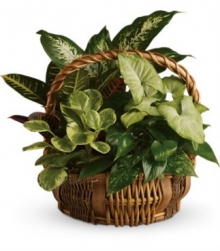Green Plants & Clean Indoor Air
Wednesday, December 29 | House Plants
The energy crisis of the 1970s promoted Americans to conserve petroleum in a number of ways; from redesigning our cars to be more fuel efficient, to tightening up our homes to keep cold air out and fuel bills down.
But, the very design changes that improved energy efficiency, in some cases actually resulted in new health problems for the 80s and 90s. Topmost on the list is a phenomenon called indoor air pollution. It's caused by a buildup of "off-gases" in superinsulated office buildings and homes. This group of harmful gases includes a number of organic compounds given off by everyday materials like building materials, fabric, furniture, cleaning compounds and cigarette smoke.
The symptoms of what is now known as "sick building syndrome" include typical allergic reactions like itchy eyes, rashes, drowsiness, sinus and respiratory congestion, and headaches. If you live or work in a new building with little ventilation, chances are, this is a problem to be aware of, especially if you smoke.
In their efforts to develop a way to keep the atmosphere in future space stations clean, NASA scientists studied the use of plants as living air filters. The results of their research is very encouraging, especially if you like houseplants. Their findings have shown that certain common houseplants are very effective at filtering organic compounds from indoor air.
The three chemicals used in the NASA screening tests are benzene, trichloroethylene and formaldehyde. Benzene is a common solvent used in gasoline, oils, paints, plastics and rubber. It is also used in the manufacture of detergents, pharmaceuticals and dyes. Trichloroethylene (TCE) is a product with a wide range of industrial uses. Dry cleaners use TCE and it can be found in printing inks, paints, lacquers, varnishes and adhesives.
Formaldehyde is probably the most commonly found material of the three. It is present in virtually all indoor environments. Particle board and presses wood products as well as urea-formaldehyde type insulations are the most common sources. But, consumer paper products like grocery bags, waxed paper, facial tissues and paper towels are treated with urea-formaldehyde resins. Many household cleaning agents, wrinkle resisters, water repellents, fire retardants and adhesive binders used in floor covering and carpet backing also contain formaldehyde. It's even present in our permanent press clothing! Cigarette smoke and heating fuels such as kerosene and natural gas are a few more common sources of formaldehyde.
Short of eliminating all of these items from our environment and installing expensive air filtration systems in our homes and offices, you must be wondering, what can we do? The answer just might lie in the NASA research findings. A dozen common houseplants were tested for their effectiveness at filtering these materials from our indoor air. They included ivy, pothos, mums, dracaenas, ficus and gerbera daisies. The plants were grown in conditions as close to those if offices and homes as possible. Left in their original pots, they were watered when they were dry and fertilized periodically with Miracle-Gro.
Scientists were also curious to see if the microbial life in the potting soil had any advantageous effect on air filtration. Each plant's ability to screen the three chemicals was tested over a 24-hour period. A measured amount of each gas was introduced into sealed chambers containing one potted plant. After 24 hours, the level of the gas was measured and compared to the amount introduced at the beginning of the test. These tests were conducted over a two-year period using a number of different concentrations of each gas. Low level testing as well as concentration far above levels found in most homes were used and factored into the final conclusions.
Data from this two-year study indicate that houseplants can contribute to keeping our indoor air safer to breathe. In fact, when some plants and potting soil were exposed to air containing toxic chemicals such as benzene, they actually become more effective air cleaners as time went on.
This wasn't as surprising to the researchers as you might think. It's a well known fact that microorganisms do adapt genetically to their surroundings. Thus, if plants are exposed to higher levels of these organic materials, they will, over time, adapt and become able to use more of these chemicals as food sources.
According to NASA, 15 to 20 houseplants from the list of those tested will purify the interior of a typical 1,800 square foot house. They do recommend that for people who smoke, activated charcoal air filters would be needed to completely clean the air. But, the plants will help. The plants that are most effective at filtering indoor air are Aglaonema (Chineese Evergreen), Spathiphyllum (Peace-lilly), Syngonium (Arrowhead vine), Hedera (Engligh ivy), Dracaena (Cornplant), and Scindapsus (Devil's ivy).





